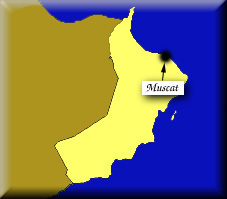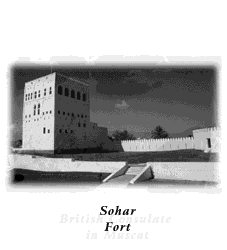|
Initial Contacts with the British
|
Oman had fallen under the sway of the Portugese in the year 1507. Superior naval tactics and technology helped secure control of the coast from the local leaders. The Portugese turned Oman into a crucial landing stage as part of their highly profitable Indies spice trade. The wealth and success of this trade attracted the interest of other European powers, most notably the British and Dutch, and it also spurred a local tribe to rise up and take control of their own destiny and resources. Oman's initial contacts with the British was part of an plan to undermine the commercial and political power of the Portugese in the area. In 1646, the Al-Ya'ribi clan made overtures to the British East India Company which resulted in a treaty guaranteeing trading, religious and legal rights for British merchants operating in the Oman. The object was clearly to weaken Portugal's control of the area. And sure enough, in 1650, Imam Sultan Bin Saif rose up against the Portugese and successfully expelled them from Muscat and Oman.
|
|
Establishment of Formal Relations
|
|
Having established favourable trading, legal and religious rights, the British East India Company didn't think that it was necessary to establish any more formal relations with the Omanis. There was no need to do so, the Omani's were happy to trade with the British and afford them many commercial advantages without the necessity of administrative cost or burden. This state of affairs was to remain in place until the end of the Eighteenth Century, when new strategic realities altered the balance of power in the region. The French had become the new competitors as Napoleon landed troops in Egypt and sought to challenge British commercial and political activities in the Indian sub-continent. This new threat meant that the British government (not the British East India Company) felt that it was necessary to firm up their relationship to Oman and its leaders. Two treaties were signed, one in 1798 and one in 1800. What marks these treaties apart from many similar Imperial era agreements is the amount of equality afforded by the British towards the Omani leaders. The treaties established more of a special relationship than any kind of unequal protectorate. Indeed, so successful was Oman that it had colonies of its own stretching from current day Pakistan down to the islands of Zanzibar and Pemba on the East African Coast. This gave Oman a commercial and financial freedom that other Gulf leaders could not hope to match. However, the special relationship with Britain did provide the Al Bu Sa'id leaders with concrete commercial and political advantages. The Royal Navy provided a peace that allowed trade to thrive, whilst the British Army could and did help the coastally based leaders from being overthrown by tribes from the interior. Britain augmented their formal relationship with the Omani leaders by further treaties of 'peace, friendship and navigation' signed in 1891, 1939 and 1951.
|
|
The Beni Boo Ali Campaign 1821
|
|
Background
After the Persian Campaign of 1809-10 to eliminate pirates, the EIC shipping had enjoyed safe passage for a few years, but the trouble started again, and by 1818 there were estimated to be 7,000 pirates on 64 ships controlling the Arabian Sea from the Persian Gulf to Kathiawar and Kutch. In 1819 a force under Sir William Grant Keir captured and destroyed several criminal strongholds, leaving a Bombay regiment (1/2nd) and 8 guns on the island of Qishm. However, one tribe of miscreants was especially powerful and ferocious; they were the Beni Boo Ali (Sons of Ali), based on the eastern corner of the Arabian peninsula in the Jalan district of Oman. The Political Agent in the Gulf, Captain Thompson of the 17th Light Dragoons, naïvely assumed he could negotiate with them, and proceeded to their base on the HMS Mercury. As the sea was too choppy to launch a small boat, he sent a man who was prepared to swim ashore, probably at Al Ruwais, with a letter. The outcome was as tragic as it was predictable; the poor man was cut to pieces.
Thompson’s Badly Planned Attack, 1820.
Thompson went to Qishm island, picked up six companies of the 1/2nd Bombay Regiment and their 8 guns, and sailed down the Gulf of Oman to Sur where he was reinforced by 2,000 men from the army of the Imam of Muscat. From there he marched 60 miles to Balad Beni Boo Ali (Place of the Sons of Ali). But they found themselves heavily outnumbered and Thompson’s lack of strategy was severely punished. They lost the 8 guns, and 270 were killed, including six British officers. The survivors retreated to the coast and went back to Qishm.
Major-General Smith’s Campaign, 1821
The grenadier companies of the 2/2nd Regiment Bombay NI were ordered to Bombay where a force was being assembled under Major-General Lionel Smith, an experienced Gulf campaigner. There was one British regiment, the 65th (2nd Yorks, later the York & Lancs) with a strength of 460 men. They were brigaded with the 1/7th Bombay NI who in 1824 were designated 13th Bombay NI (113th Infantry in 1903). The rest were Bombay units including the 1st European Regiment (103rd Royal Bombay Fusiliers, in 1881 2nd Royal Dublin Fusiliers) . One battalion was made up of the grenadier companies of four Native Infantry battalions, one of which was the 2/2nd NI. There was also 1st Troop of Bombay Horse Artillery Battery with 12-pounders, and 2nd Bombay Foot Artillery with two 18-pounders. The grenadiers of the 2/2nd embarked at Malwan on 19 Dec 1820, arriving at Bombay on 24 Dec. The whole force left Bombay on 11 Jan 1821 and sailed to Sur, arriving on 27 Jan, where they were provided with camels and troops by the Imam of Muscat. They marched to a camp 2 miles inland.
Attack on the Camp, 10 Feb 1821
On the night of 9/10 Feb the camp was attacked by 500 tribesmen from the Beni Boo Ali. The attack took the force by surprise as the piquets had been ordered to carry unloaded muskets to avoid false alarms. The Bombay European Regiment was the worst hit in this attack, losing one officer, Captain Parr, and 9 men killed, as well as their bhisti. But the enemy, who were armed with spears and heavy swords, were beaten off, losing 12 killed and 20 wounded. The 2/2nd NI grenadiers had been relocated to join the 1/2nd, the battalion that had been posted to Qishm and was part of Thompson’s expedition. This battalion lost 3 men killed and 6 wounded in the attack. The camels had been scattered and it took several days to collect them all.
Belad Beni Boo Ali, 2 Mar 1821
The force of British, Indian and Omani troops needed to move quickly so that the Beni Boo Ali would not have too much time to prepare for an attack. To this end the tents were left behind, as well as the 18-pounder guns, and the men put on reduced rations. The march was through difficult country with very little water, and the men suffered greatly. They reached the fortified town of Belad Beni Boo Ali on 2 Mar 1821. Shots were fired from the town but the battle took place near a grove of date palms two miles away. Arabs occupied a defensive position there and the 2nd Brigade were ordered to attack. This brigade contained the 65th and the 1/7th Bombay NI. Their light companies were in front with the 65th behind and the 1/7th at the rear. Two Horse Artillery 6-pounders were placed, one on each flank. As they approached, the Arabs suddenly rushed out of the palm grove and, even though they were under fire, managed to get between the two regiments. The 65th Regiment turned about, fired on them and charged with the bayonet, while the 1/7th NI fought them off, and the guns fired grapeshot at them. This phase of the battle lasted 15 minutes during which the tribesmen lost about 200 killed. The casualties of Smith’s force were 201 killed or wounded, nearly all of which belonged to the 65th or the 1/7th NI. The grenadier companies of the 2/2nd had no casualties.
The main stronghold of the Beni Boo Ali was the next objective and as the two brigades prepared for a siege a white flag was seen to be hoisted on the walls, but they were not prepared to give up their weapons, so the guns were brought up to batter the walls for an assault by the 1st Brigade , which contained the grenadiers of the 2/2nd NI. However, the Arabs were reported to be escaping from the rear of the fort, so men were sent round to intercept them. They arrested 236 prisoners of which 96 were wounded. The chief, Mahomed bin Ali and his brother, Kadeem bin Ali were both amongst the wounded prisoners. The guns that had been captured from Captain Thompson’s failed attack the previous year, were retrieved. The battle honour BENI BOO ALLI was authorised on 11 Feb 1831.
|
|
Administration
|
|
Not being a formal colony or protectorate, Britain's involvement with Oman was a very subtle one, but nonetheless powerful for all that. A combination of a political consul at the Omani court in Muscat and the presence of the Royal Navy based in Bushire and ships constantly to-ing and fro-ing between Europe and India, meant that effective political control was never seriously doubted. To illustrate the power the British could exert over the Al-Bu Sa'id leaders, you only have to look at how Britain effectively enforced its own anti-slavery policy on the Omani leaders and traders. From the second half of the Nineteenth Century, this helped the Omani economy into an economic slump that was further compounded by political events after the death of Sa'id Ibn Sultan in 1856. In the subsequent succession crisis the British effectively split the Omani empire into two; one based on Muscat and the other on Zanzibar. This further weakened the Omani economy and ruling family. Perversely, this weakening of the country, actually made the ruling family more dependent upon the British for their existence. The British, therefore, provided successive Sultans with political and military support to keep them in position. From the middle of the Eighteenth Century, the regular British army provided most of the officers and training for the Omani armed forces.
The first occasion that the British were required to maintain the regime was after the death of Sultan Faisal Bin Turki in 1913. With no clear line of succession in Arab families, succession crises became a common occurence throughout the Middle East. On this occasion, tribes from the interior went so far as to attempt to sack Muscat. It was only the presence of British troops and officers that prevented the regime from being overthrown. An uneasy truce was called into existence between the Sultan, whose powerbase lay on the coast, and the Imam, who claimed to rule the interior tribes.
The British would also be called upon to prevent Ibn Saud from exerting too much influence and power in the Omani realms as he swept victoriously through the remains of the Ottoman Empire at the end of The Great War. As the principle financial backers of Ibn Saud, they could make sure that he did not get too carried away with his successes and try to take control of large areas of Oman. However, borders in the desert were difficult to police and agree upon, a fact that would come back to haunt the British and the Omani leaders when oil raised the political stakes in the region in the 1950's.
The Buraimi crisis in the 1950's was a complex series of political loyalties and strategic imperatives that pitted the Omani regime and the British against the Saudis and tribes from the interior. It demonstrated how, even in a period as late as the 1950's, the British could still exert decisive political and military action in the area. In return for oil concessions, the British provided Sultan Said Ibn Taimur with the necessary political and military support to eject the Saudis and to destroy the powerbase of the interior tribes once and for all. Yet again, the ability of a weak regime to call upon British support allowed it to continue in existence when many lesser regimes would have fallen by the wayside. Oman was never a formal British colony, but the extent of its dependence upon the British certainly made it seem as if it was. Indeed, Sultan Said was such an anglophile that he came to depend on the British (and a few local trading families) to what was perhaps a dangerously unhealthy degree and one that resulted in political and economic stagnation for the country. So much so, that even the British were concerned for the political future of this country and it is possible that they were instrumental in securing a bloodless coup that allowed Sultan Qaboos (Said's son) to come to power in 1970. Britain has always denied any involvement, but this seems unlikely given that the army was mostly commanded by British officers at the time.
|
|
Role within the Empire
|
|
Oman was primarily a commercial staging post between Europe and the Indian sub-continent. It was also at the center of a dynamic regional trading hub that connected India, the Middle East and East Africa. Shipping companies and businesses were content to work in the relatively peaceful framework of the Omani empire of the eighteenth and early nineteenth centuries. Ships from the British Indian Navy would regularly call on the ports of Oman on their way to and from Europe or as part of anti-piracy or slavery drives. As European ships improved in technology and as the British developed alternative naval facilities in Aden and at Suez, the importance of Oman began to wane. This was further compounded by the curtailment of the slave trade and the stripping of the Zanzibari possessions from Muscat. Oman slipped in economic and strategic importance until the discovery of oil in the region in the 1940's and 50's. This reinvigorated Britain's interest in the area and ensured that the British would try to maintain strong diplomatic, military and political relations with the regime.
|
|
Withdrawal from Empire
|
|
In 1968, the British announced that they would formally withdraw from the Gulf region by the year 1971. However, the strong, and technically informal, relationship that Britain held with Oman meant that the abondonment was not as sudden or as precipitate as it was with the other Gulf countries. This is perhaps best illustrated by the extent that they helped establish Sultan Qaboos as the leader of the country. They also provided troops to help suppress the Dhofar rebellion in the years 1973 to 1976. Britain's relative decline in international terms has meant that its power has been reduced somewhat, but perhaps more than with any other country the British have maintained an uncommonly strong relationship with the country of Oman.
|
|
|
| Maps of Oman
|

|
1660 Map of the Middle East
1765 Map of the Middle East
|
| Imperial era flag of Oman
|

|
| Images of Imperial Oman
|

|
|
Historic Oman Images
|
| Articles
|
Britain's Arabian Oil Empire
David Holden gives an account of how Britain's involvement in the Middle East mutated from a Nineteenth Century concern about security of maritime trade routes and the defence of India into a Twentieth Century preoccupation of guarding the flow of oil and attempts to contain rising nationalist aspirations in the region.
|
| Timeline
|
|
1507
|
Portugese occupy Oman
|
|
1646
|
Signs Treaty with British East India Company
|
|
1650
|
Expulsion of Portugese
|
|
1749
|
Ahmed Bin Said becomes the first Al-Busaid imam
|
|
1786
|
Muscat becomes capital city
Al-Busaids take title of Sultan
|
|
1798
|
Treaty with British government
|
|
1800
|
Treaty of Protection with British government
|
|
1842
|
Omani empire divided into two: Zanzibar is split from Muscat and Oman
|
|
1891
|
Treaty of Peace, friendship and navigation with Britain
|
|
1913
|
Death of Sultan Turki results in tribal unrest
|
|
1915
|
Interior tribes ride on Muscat, repelled by British
|
|
1920
|
Sultan and Imam sign treaty at Seeb
|
|
1939
|
Treaty of Peace, friendship and navigation with Britain
|
|
1951
|
Treaty of Peace, friendship and navigation with Britain
|
|
1952
|
Saudis ejected from Buraimi oasis by British and Omanis.
|
|
1955 - 59
|
Power of Imamate curbed in the interior by joint Sultan and British action
|
|
|
Rulers of Oman
|
Ahmed Bin Said
1744 - 1783
|
Said
1783
|
Hamad
1784 - 1792
|
Sayyid Sultan bin Ahmed
1792 - 1804
|
Sa'id Ibn Sultan
1807 - 1856
|
Ibn Sa'id
1856 -1868
|
----
1868 -1873
|
----
1873 -1888
|
Faisal Ibn Turki
1888 - 1913
|
Taimur Ibn Faisal
1913 - 1932
|
Said Ibn Taimur
1932 - 1970
|
Qabus Ibn Said
1970 -
|
| Articles
|
The Sultanate of Oman: A Forgotten Empire
|
|
Suggested Reading
|
The Ottoman Gulf
by Frederick Anscombe
An Imperial Twilight
by Sir Gawain Bell
Oman Since 1856
by Robert Geran Landen
Oman in the Twentieth Century: Political Foundations of an Emerging State
by J Peterson
Oman a History
by Wendell Phillips
Oman & Muscat: an early modern history
by Patricia A. Risso
The Making of the Modern Gulf States: Kuwait, Bahrain, Qatar, the United Arab Emirates and Oman
by Rosemarie Said Zahlan
|
|
